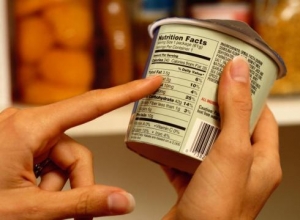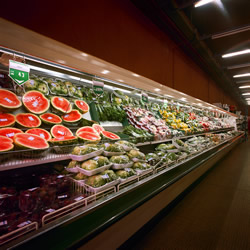 Down The Aisle
Down The Aisle
We visit the grocery store an average of 2.2 times a week, which gives us plenty of opportunities to pick up items that can pack on pounds. Try these tips when you go shopping, they can help you pass up the pastries and other diet-busting goodies the next time you head down those aisles.
Picking through a small, dark produce section with half-empty bins and limp-looking fruits and veggies could make anyone head for the cookie aisle. Choose a bright, clean market with varied produce and lean meat selections, If it has a healthy foods section, or specializes in whole foods all the better.
Take 10
Spending just 10 minutes mapping out your menu for the week will help you stay on track. If you have the ingredients for healthy meals at home, you are less likely to order high-cal takeout.
Stop at the ATM. Paying with cash keeps you from splurging on extra items or calories. If you take only what your shopping list requires or budget allows, you can’t buy unnecessary extras.
Head off hunger by grabbing a delicious snack or stopping for a small, fat-free frozen yogurt or fresh fruit smoothie before you shop. Satisfied shoppers are less likely to be tempted by calorie-laden impulse items.
Children can undermine your best intentions. Having kids with you when you shop can influence what you choose to buy. If shopping solo isn’t an option, tame the “I want candy” tantrums by taking toys or healthy treats to keep kids occupied. Or give them responsibility for choosing healthy items.
Get in the mood.
If you’re sad, mad or generally feeling blah, it’s easy to reach for ice cream or chips. Instead, play upbeat music in the car or take a few moments to unwind before entering the supermarket.
Some consumers make better choices in the evening, after they’ve eaten dinner and the bakery is closed, while others find they have more resolve in the a.m. hours. When possible, shop at the time that works best for you.
Also, spend most of your time on the outside perimeter of the grocery store, where the mainstays of a nutritious diet — fresh produce, meat, and dairy products — are generally found, and less time in the center aisles where the processed foods are located.
 Your Grocery Shopping List
Your Grocery Shopping List
Writing and sticking to your grocery list is essential to make sure you’re loading up your cart with healthy food choices. break down your list into staple items that fit into five basic categories:
 Fresh produce.
Fresh produce.
While it’s good to have a list of staples, be sure to choose a variety of fresh fruits and vegetables. Most people will eat the same fruits and vegetables every day, which means they aren’t getting the nutrient density that they need, and can easily get bored and burned out. Frozen fruits and vegetables can be a good way to add variety when fresh produce isn’t in season.
 Proteins.
Proteins.
As with produce, get a variety of proteins — just make sure they’re lean. And keep fat content in mind: Look for ground beef or turkey that’s at least 93 percent fat-free. Lean turkey, lean ground beef, lean cuts of steak such as flank and sirloin, and skinless chicken are all great options for your weekly list. Eggs, including egg white-only products, are another way to add variety to your proteins. Also, be sure to put fish on your grocery shopping list and weekly menu. Look for sole or another white fish when you’re looking for a lean choice as well as salmon to help you get enough essential fatty acids.
Whole Grains.
Create a list of different whole grains for the week. Staples can include whole-wheat pasta and brown rice; whole-grain crackers; cereal and oatmeal. Check the labels: Stick to choices that have more than 3 grams of fiber per serving, part of a daily goal of 25 to 35 grams of fiber.
 Fats.
Fats.
You do need some fats in your diet — it’s simply a matter of choosing healthy fats and limiting them to an appropriate amount. Options can include natural peanut, almond, and cashew butters. Avocados, nuts and seeds, and olive oil are also good staples for your grocery shopping list. “These provide mono- and polyunsaturated fats, which help to decrease cholesterol
 Dairy.
Dairy.
As you’re trying to lose weight, we suggests choosing fat-free dairy foods. If you’re just looking to eat healthfully, you can opt for low-fat dairy products, which preserve more taste but still contain less fat and calories than whole-milk cheeses and other dairy products. Good fat-free options include fat-free milk and fat-free Greek yogurt.
 Allow yourself time to explore new products that come on the market. you may find some newly packaged salads you can pack for lunches or foods per-prepped to make cooking healthy meals a snap. Check out new spices and herbs to add flavor without adding calories to your meals.
Allow yourself time to explore new products that come on the market. you may find some newly packaged salads you can pack for lunches or foods per-prepped to make cooking healthy meals a snap. Check out new spices and herbs to add flavor without adding calories to your meals.
Making Good Choices: Unhealthy Foods to Avoid
Sodium is a key ingredient to look out for. Some canned soups look like they’re good choices because they have vegetables and chicken and are low in fat, but these are often high in sodium. Cottage cheese is also typically high in sodium, as are deli meats, even the lean cuts.
Instead, opt for low-sodium soup when you can, and ask for low-sodium lunch meats at your deli counter. Remember to factor the salt content of any product into your daily sodium total. You can still eat foods with sodium — they just shouldn’t be the mainstays of your diet. “Make sure your product doesn’t have more than 300 to 400 milligrams of sodium per serving.
 Check condiment labels before you buy:
Check condiment labels before you buy:
Condiments, such as sauces, mayonnaise, and salad dressings, can be packed with fat and calories, as well as salt. Look for a vinaigrette or oil-based dressing instead of a creamy one, and try low-fat mayonnaise or mayonnaise made with olive oil. You can also try topping your favorite sandwiches with mustard, which is generally a healthier condiment choice.
Sodas are a Bandster No No
(even the diet kind) not to mention loaded with sugar and calories, so it’s best to cross them off your grocery list for good if you are shopping for just yourself. If you are shopping for others, don’t make the mistake of saying “I’m buying these things for the family”, they always find a way to tempt you into eating them if they are readily available. So forgo desserts such as cakes, cookies, candy, and pastries. Instead consider talking to your family about picking up their own treats and keeping them out of sight or even going out as a family and sharing dessert or getting a healthier low-fat yogurt as a treat if you just have to have it. Remember that everything in moderation is fine.
Arming yourself with a strategy, a grocery shopping list, and a good understanding of healthy and unhealthy foods means you’ll make the most of every grocery shopping trip.





